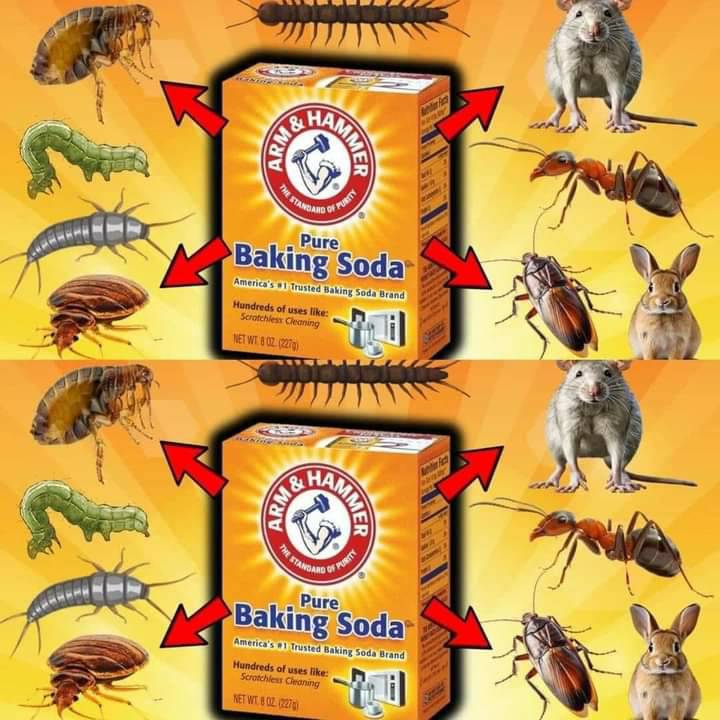Have you ever considered that a common kitchen staple like baking soda could be your ally in pest control? This versatile ingredient, known for making cakes fluffy and aiding in household cleaning, also proves remarkably effective against pests such as fleas, mice, ants, and more. By understanding how to use baking soda properly, you can tackle these pesky invaders efficiently and safely.
Fleas: A Pet Owner’s Dilemma
Fleas can be a nuisance, especially for pet owners, causing discomfort for both pets and humans. To combat them with baking soda, follow these steps:
- Preparation: Mix equal parts of baking soda and salt. This combination works by dehydrating the fleas, leading to their demise.
- Application: Sprinkle the mixture generously on carpets, pet bedding, and any areas where your pets frequent.
- Waiting Period: Allow the mixture to sit for a few hours. This time allows the baking soda and salt to dehydrate the fleas effectively.
- Cleaning Up: After a few hours, thoroughly vacuum the treated areas. This helps to remove not only the fleas but also their eggs, preventing further infestations.
Mice and Rats: Unwanted House Guests
Mice and rats can cause significant damage and pose health risks. Here’s how to use baking soda to deter these rodents:
- Sprinkling Method: Sprinkle baking soda in areas where mice and rats are commonly seen. These rodents dislike the taste and smell of baking soda, which can help deter them from these areas.
- Bait Method: Mix baking soda with sugar to create an attractive bait. The sugar draws them in, and once ingested, the baking soda reacts with their stomach acids, causing internal complications that prove fatal.
Cockroaches: Persistent Invaders
Cockroaches are notoriously difficult to eliminate, but baking soda can be an effective tool:
- Bait Preparation: Mix equal parts of baking soda and sugar. The sugar attracts the cockroaches, enticing them to ingest the mixture.
- Strategic Placement: Place the mixture near entry points, in corners, and other hiding spots where cockroaches are likely to travel. The baking soda they consume will ultimately prove fatal.
Ants: Managing a Common Problem
Ants are drawn to sugary substances, and baking soda can disrupt their colonies:
- Bait Mix: Combine baking soda with powdered sugar. The sugar attracts the ants, while the baking soda is the active ingredient that harms them.
- Application: Sprinkle the mixture along ant trails and near entry points. The ants will carry the mixture back to their colony, reducing their population over time.
Bedbugs and Centipedes: Targeting Specific Pests
For specific pests like bedbugs and centipedes, baking soda can be particularly effective:
- Bedbugs:
- Direct Application: Sprinkle baking soda directly onto bed frames, mattresses, and other infested areas. The baking soda absorbs moisture from the bedbugs’ bodies, leading to dehydration and death.
- Centipedes:
- Habitat Disruption: Dust baking soda in areas where centipedes are found. This disrupts their habitats and discourages their presence.
Using Baking Soda Safely
While baking soda is non-toxic compared to chemical pesticides, it is still essential to use it safely:
- Keep Away from Children and Pets: Ensure that treated areas are not accessible to children and pets during and after application.
- Good Ventilation: Apply baking soda in well-ventilated areas to avoid inhalation.
- Regular Cleaning: Regularly vacuum or clean treated areas to remove any residual baking soda and dead pests.
Conclusion
Incorporating these simple tips can make baking soda a valuable part of your pest management strategy, helping to maintain a more comfortable and pest-free home. Next time you’re at the store, consider picking up an extra box—not just for baking, but for effective pest control as well!
By harnessing the power of baking soda, you can address various pest problems naturally and safely, ensuring a healthier living environment for you and your family.
